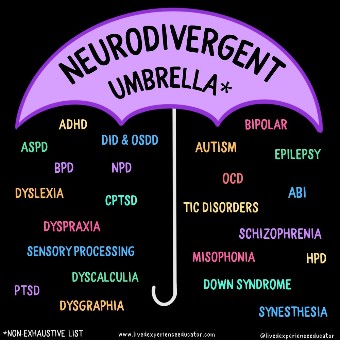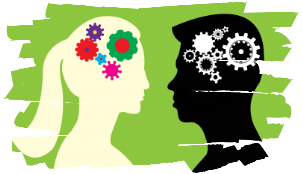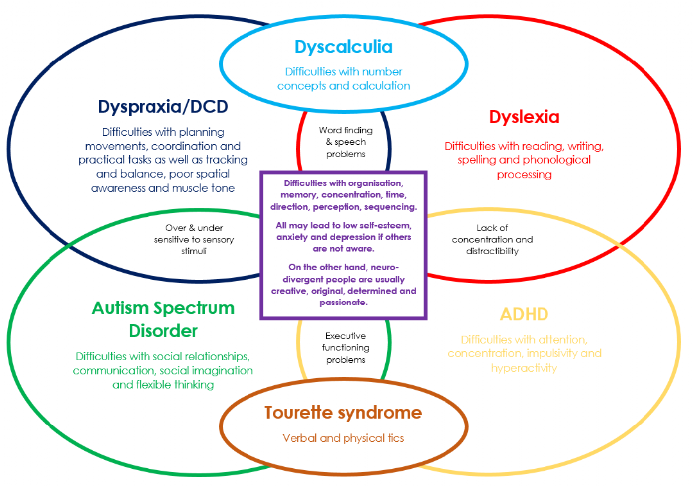People who have a brain that works typically are known as neurotypical. People who have a brain that doesn't work typically are known as neurodivergent. Being neurodivergent is neither good nor bad: it's just a variation in how the brain works.
Some types of neurodivergent brain have been given labels due to groups of characteristics being common with a particular group of people. This picture shows many of these labels.

Labels are useful to a certain extent especially if someone needs to access additional support. We believe it's more important to understand an individual's strengths and challenges as it's unusual for a neurodivergent person to only associate with one label as there is a lot of crossover.
It's important that children don't feel that they are defined by a label and that we always keep in focus the person behind the label. Making assumptions or deciding expectations based on a child's label(s) is never helpful and only leads to the child feeling frustrated and misunderstood.
At Kickstart Learning, we explore a child's diagnoses with them (with parent permission)
Often neurodivergent conditions are classed as disabilities as neurodivergent people tend to struggle with particular aspects of living in a neurotypical world and sometimes need additional support to be able to function sufficiently well. It's really important to recognise that neurodivergent people are only usually 'disabled' as they are measured by neurotypical standards. It's like judging how successful an animal is by how far it's able to fly when some animals are not physically able to fly.
In schools, this has a huge impact on neurodivergent children and is why the majority of neurodivergent children find school so hard and end up experiencing trauma and mental health difficulties. The neurotypical expectation of a child at school is that they sit still, they follow the teacher's instructions, they are quiet when in the classroom, they sit and write for lengths of time etc. Some neurodivergent children are not able to do these things as their brain doesn't work that way. They get told they need to try harder when they are already trying their best; they get punished for not being able to do something that isn't possible for them to do; they get told that how they do things is wrong and told to do things more like the neurotypical children.
Neurodivergent children often have low self-esteem and is it any wonder why?! They are continually told that they are wrong and that their best is not good enough. They are made to feel that something is wrong with them and that they need fixing.
Many neurodivergent children start masking at school and try to be more like the neurotypical children as a way to protect themselves. Imagine having to put on an act and pretend you're someone who you're not for around six or seven hours every day. This is incredibly damaging and is another reason that many neurodivergent children find school traumatic. They leave school not knowing who they really are but knowing that being their real self is bad and to be avoided at all costs.

Overall, more boys than girls are diagnosed with Specific Learning Difficulties. This is still a hot topic for debate as people are beginning to realise that the ratios are probably closer than the statistics suggest as girls aren't often as easy to diagnose.
More boys than girls are diagnosed with ASD. It has been said that the ratio could be as high as 10:1, but it has been suggested that a ratio of 4:1 is more accurate. Many girls are never diagnosed because their difficulties can present much differently to boys. For example, when boys have problems reading social cues and body language, knowing the right thing to do in public, waiting their turn, and developing empathy for others they tend to act out in aggressive ways that get adult attention. Girls, on the other hand, tend to suffer in silence and appear shy and passive. Girls with ASD typically use their average to above-average intelligence to hide their social difficulties. They learn as many social rules as they can and apply them fairly convincingly. Often, they put a permanent smile on their face and constantly try to please others. Some social scientists believe that girls are better at developing ways of camouflaging their disorder because they are socialised to be passive.
In ADHD, the developmental trajectory for girls is the opposite of boys. Boys tend to have more severe symptoms when they are younger and their hyperactivity decreases significantly following puberty. Girls' symptoms, on the other hand, intensify as estrogen builds in their systems meaning that they often experience more severe symptoms once they hit puberty. Boys tend to experience the typical presentation of hyperactivity whereas girls tend to be hyper-talkative, hyper-social and hyper-emotional rather than physically hyperactive. Before puberty, girls can often appear to be passive students - daydreaming and being reluctant to draw attention to themselves or ask for help. Consequently, their intellect and abilities are often underestimated.

